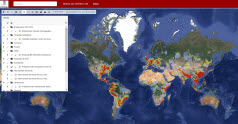After decades of inactivity, the Tokositna Glacier is rumbling and crackling through the craggy peaks of the Alaska Range The unexpected journey caught experts by surprise and delighted tourists with a rare view of a force that shapes the earth."A lot of film has been used up on the Tokositna," said Bill Post, a pilot for K2 Aviation who regularly takes tourists on scenic flights through the Alaska Range and carries climbers to nearby Mount McKinley .
The Tokositna, about 200 miles north of Anchorage, suddenly began surging in late February, moving forward at a rate of about eight feet per day, a pretty zippy for an alpine glacier, said Guy Adema, the National Park Service's glaciologist at Denali National Park and Preserve. And when a 20-mile-long river of ice more than 1,000-feet thick, starts moving forward, people notice.
Local pilots from the nearby town of Talkeetna were the first to see the dramatic changes on the glacier, which starts near the base of Mount Huntington .
Bulges and depressions eventually measuring hundreds of feet in height and depth began rippling down the Tokositna's normally flat surface. The edges of the glacier shredded as they scraped along the valley walls, carrying tons of rock and dirt along for the ride. Perhaps the most dramatic indication that the glacier was on the move was when fresh crevasses, blackened with dirt, were exposed within days of a heavy snowfall."That really confirmed it," Adema said. "Those fresh cracks reveal it all."
At the rate the Tokositna is surging, Adema thinks it could eventually mow down the cottonwoods, birches and brush now growing just beyond its leading edge.There are about 40 glaciers in Denali , covering about one million acres. About one-quarter are surge-type glaciers, that gallop forward suddenly at a rapid rate. When a surge occurs, it offers an opportunity to view the powerful forces that carved valleys of the Alaska Range in the distant past."It's a chance to see the natural surroundings change within a season. There aren't especially that many natural processes that happen within that timeframe," Adema said. "This valley will look quite a bit different this year than it did last year."
Surges are generally thought to be caused by a buildup of meltwater beneath the glacier, Adema said."We think it has something to do with the water outlets being blocked," he said. When the water builds up, it acts as a lubricant, allowing the glacier to slide forward at a much faster-than-normal rate.While scientists think they know how glaciers surge, they're not exactly sure why.
Adema and two field technicians camped beside the Tokositna for three days last month, skiing across its surface, measuring its movement and listening to the sounds of large blocks of ice falling away as the glacier moved forward.
Scientists are trying to get a better understanding of the dynamics of surging glaciers and what role, if any, climate plays in their activity. Surge-type glaciers tend to take off at regular intervals, ranging anywhere from 10 to 100 years
A surge generally starts in late winter and lasts through the summer, sometimes resuming the following summer before the glacier eventually comes to rest, Adema said.
Source : Nature
 s'abonner
s'abonner





































